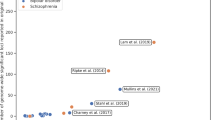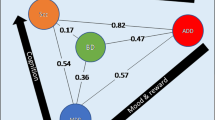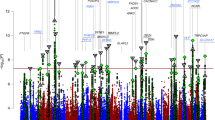Abstract
Bipolar disorder (BD) is a prevalent mood disorder that tends to cluster in families. Despite high heritability estimates, few genetic susceptibility factors have been identified over decades of genetic research. One possible interpretation for the shortcomings of previous studies to detect causative genes is that BD is caused by highly penetrant rare variants in many genes. We explored this hypothesis by sequencing the exomes of affected individuals from 40 well-characterized multiplex families. We identified rare variants segregating with affected status in many interesting genes, and found an enrichment of deleterious variants in G protein-coupled receptor (GPCR) family genes, which are important drug targets. Furthermore, we showed targeted downstream GPCR dysregulation for some of the variants that may contribute to disease pathology. Particularly interesting was the finding of a rare and functionally relevant nonsense mutation in the corticotropin-releasing hormone receptor 2 (CRHR2) gene that tracked with affected status in one family. By focusing on rare variants in informative families, we identified key biochemical pathways likely implicated in this complex disorder.
This is a preview of subscription content, access via your institution
Access options
Subscribe to this journal
Receive 12 print issues and online access
$259.00 per year
only $21.58 per issue
Buy this article
- Purchase on Springer Link
- Instant access to full article PDF
Prices may be subject to local taxes which are calculated during checkout


Similar content being viewed by others
References
Subramaniam M, Abdin E, Vaingankar JA, Chong SA. Prevalence, correlates, comorbidity and severity of bipolar disorder: results from the Singapore Mental Health Study. J Affect Disord 2013; 146: 189–196.
Kessler RC, Chiu WT, Demler O, Merikangas KR, Walters EE. Prevalence, severity, and comorbidity of 12-month DSM-IV disorders in the National Comorbidity Survey Replication. Arch Gen Psychiatry 2005; 62: 617–627.
McDonald KC, Bulloch AG, Duffy A, Bresee L, Williams JV, Lavorato DH et al. Prevalence of bipolar I and II disorder in Canada. Can J Psychiatry 2015; 60: 151–156.
Clemente AS, Diniz BS, Nicolato R, Kapczinski FP, Soares JC, Firmo JO et al. Bipolar disorder prevalence: a systematic review and meta-analysis of the literature. Rev Bras Psiquiatr 2015; 37: 155–161.
Mamdani F, Groisman IJ, Alda M, Turecki G. Pharmacogenetics and bipolar disorder. Pharmacogenomics J 2004; 4: 161–170.
Smoller JW, Finn CT. Family, twin, and adoption studies of bipolar disorder. Am J Med Genet C Semin Med Genet 2003; 123C: 48–58.
Alda M, Hajek T, Calkin C, O'Donovan C. Treatment of bipolar disorder: new perspectives. Ann Med 2009; 41: 186–196.
Cruceanu C, Alda M, Rouleau G, Turecki G. Response to treatment in bipolar disorder. Curr Opin Psychiatry 2011; 24: 24–28.
Craddock N, Sklar P. Genetics of bipolar disorder. Lancet 2013; 381: 1654–1662.
Neale BM, Sklar P. Genetic analysis of schizophrenia and bipolar disorder reveals polygenicity but also suggests new directions for molecular interrogation. Curr Opin Neurobiol 2015; 30C: 131–138.
Shinozaki G, Potash JB. New developments in the genetics of bipolar disorder. Curr Psychiatry Rep 2014; 16: 493.
Manchia M, Cullis J, Turecki G, Rouleau GA, Uher R, Alda M. The impact of phenotypic and genetic heterogeneity on results of genome wide association studies of complex diseases. PLoS ONE 2013; 8: e76295.
Bodmer W, Bonilla C. Common and rare variants in multifactorial susceptibility to common diseases. Nat Genet 2008; 40: 695–701.
Gould TD, Manji HK. Signaling networks in the pathophysiology and treatment of mood disorders. J Psychosomatic Res 2002; 53: 687–697.
Xu X, Muller-Taubenberger A, Adley KE, Pawolleck N, Lee VW, Wiedemann C et al. Attenuation of phospholipid signaling provides a novel mechanism for the action of valproic acid. Eukaryot Cell 2007; 6: 899–906.
Alda M. Lithium in the treatment of bipolar disorder: pharmacology and pharmacogenetics. Mol Psychiatry 2015; 20: 661–670.
Li H, Durbin R. Fast and accurate short read alignment with Burrows-Wheeler transform. Bioinformatics 2009; 25: 1754–1760.
Genomes Project C, Abecasis GR, Auton A, Brooks LD, DePristo MA, Durbin RM et al. An integrated map of genetic variation from 1092 human genomes. Nature 2012; 491: 56–65.
NHLBI GO Exome Sequencing Project (ESP). Available at: http://evs.gs.washington.edu/EVS/.
Drmanac R, Sparks AB, Callow MJ, Halpern AL, Burns NL, Kermani BG et al. Human genome sequencing using unchained base reads on self-assembling DNA nanoarrays. Science 2010; 327: 78–81.
Kazius J, Wurdinger K, van Iterson M, Kok J, Back T, Ijzerman AP. GPCR NaVa database: natural variants in human G protein-coupled receptors. Hum Mutat 2008; 29: 39–44.
Samocha KE, Robinson EB, Sanders SJ, Stevens C, Sabo A, McGrath LM et al. A framework for the interpretation of de novo mutation in human disease. Nat Genet 2014; 46: 944–950.
Petrovski S, Wang Q, Heinzen EL, Allen AS, Goldstein DB. Genic intolerance to functional variation and the interpretation of personal genomes. PLoS Genet 2013; 9: e1003709.
Nature Reviews Drug Discovery GPCR Questionnaire Participants. The state of GPCR research in 2004. Nat Rev Drug Discov 2004; 3: 575, 577–626.
Lovenberg TW, Liaw CW, Grigoriadis DE, Clevenger W, Chalmers DT, De Souza EB et al. Cloning and characterization of a functionally distinct corticotropin-releasing factor receptor subtype from rat brain. Proc Natl Acad Sci USA 1995; 92: 836–840.
Markovic D, Punn A, Lehnert H, Grammatopoulos DK. Intracellular mechanisms regulating corticotropin-releasing hormone receptor-2beta endocytosis and interaction with extracellularly regulated kinase 1/2 and p38 mitogen-activated protein kinase signaling cascades. Mol Endocrinol 2008; 22: 689–706.
Turecki G, Grof P, Grof E, D'Souza V, Lebuis L, Marineau C et al. Mapping susceptibility genes for bipolar disorder: a pharmacogenetic approach based on excellent response to lithium. Mol Psychiatry 2001; 6: 570–578.
Grof P, Duffy A, Alda M, Hajek T. Lithium response across generations. Acta Psychiatr Scand 2009; 120: 378–385.
Cruceanu C, Tan PP, Rogic S, Lopez JP, Torres-Platas SG, Gigek CO et al. Transcriptome sequencing of the anterior cingulate in bipolar disorder: dysregulation of G protein-coupled receptors. Am J Psychiatry 2015; 172: 1131–1140.
Muhleisen TW, Leber M, Schulze TG, Strohmaier J, Degenhardt F, Treutlein J et al. Genome-wide association study reveals two new risk loci for bipolar disorder. Nat Commun 2014; 5: 3339.
Racagni G, Popoli M. Cellular and molecular mechanisms in the long-term action of antidepressants. Dialogues Clin Neurosci 2008; 10: 385–400.
Fries GR, Vasconcelos-Moreno MP, Gubert C, dos Santos BT, Sartori J, Eisele B et al. Hypothalamic-pituitary-adrenal axis dysfunction and illness progression in bipolar disorder. Int J Neuropsychopharmacol 2014; 18, pyu043.
Okamoto Y, Shikano S. Phosphorylation-dependent C-terminal binding of 14-3-3 proteins promotes cell surface expression of HIV co-receptor GPR15. J Biol Chem 2011; 286: 7171–7181.
Maurice P, Guillaume JL, Benleulmi-Chaachoua A, Daulat AM, Kamal M, Jockers R. GPCR-interacting proteins, major players of GPCR function. Adv Pharmacol 2011; 62: 349–380.
Benovic JL, Kuhn H, Weyand I, Codina J, Caron MG, Lefkowitz RJ. Functional desensitization of the isolated beta-adrenergic receptor by the beta-adrenergic receptor kinase: potential role of an analog of the retinal protein arrestin (48-kDa protein). Proc Natl Acad Sci USA 1987; 84: 8879–8882.
Benzing T, Yaffe MB, Arnould T, Sellin L, Schermer B, Schilling B et al. 14-3-3 interacts with regulator of G protein signaling proteins and modulates their activity. J Biol Chem 2000; 275: 28167–28172.
Bhattacharyya S. Inside story of group I metabotropic glutamate receptors (mGluRs). Int J Biochem Cell Biol 2016; 77(Pt B): 205–212.
Ayoub MA, Angelicheva D, Vile D, Chandler D, Morar B, Cavanaugh JA et al. Deleterious GRM1 mutations in schizophrenia. PLoS ONE 2012; 7: e32849.
Frank RA, McRae AF, Pocklington AJ, van de Lagemaat LN, Navarro P, Croning MD et al. Clustered coding variants in the glutamate receptor complexes of individuals with schizophrenia and bipolar disorder. PLoS ONE 2011; 6: e19011.
Menke A, Samann P, Kloiber S, Czamara D, Lucae S, Hennings J et al. Polymorphisms within the metabotropic glutamate receptor 1 gene are associated with depression phenotypes. Psychoneuroendocrinology 2012; 37: 565–575.
Acknowledgments
We thank the participants and their families for their contribution to this research. Furthermore, we acknowledge Karine Lachapelle and Annie Levert from the laboratory of GAR for technical assistance. This work was funded through a grant from Genome Quebec.
Author information
Authors and Affiliations
Contributions
All individuals included as authors have contributed substantially to the scientific process by participating in the study design, execution and the redaction of the manuscript.
Corresponding authors
Ethics declarations
Conflict of Interest
The authors declare no conflict of interest.
Electronic supplementary material
Rights and permissions
About this article
Cite this article
Cruceanu, C., Schmouth, JF., Torres-Platas, S.G. et al. Rare susceptibility variants for bipolar disorder suggest a role for G protein-coupled receptors. Mol Psychiatry 23, 2050–2056 (2018). https://doi.org/10.1038/mp.2017.223
Received:
Revised:
Accepted:
Published:
Issue Date:
DOI: https://doi.org/10.1038/mp.2017.223
This article is cited by
-
Evaluating the role of common risk variation in the recurrence risk of schizophrenia in multiplex schizophrenia families
Translational Psychiatry (2022)
-
Rare variants implicate NMDA receptor signaling and cerebellar gene networks in risk for bipolar disorder
Molecular Psychiatry (2022)
-
Exome sequencing in bipolar disorder identifies AKAP11 as a risk gene shared with schizophrenia
Nature Genetics (2022)
-
Translational genomics and beyond in bipolar disorder
Molecular Psychiatry (2021)
-
Exemplar scoring identifies genetically separable phenotypes of lithium responsive bipolar disorder
Translational Psychiatry (2021)



